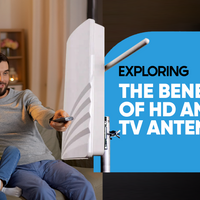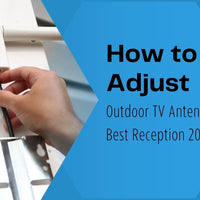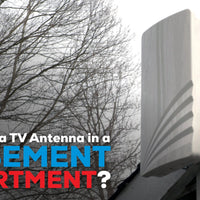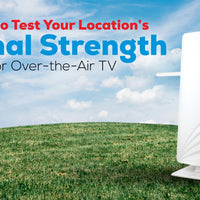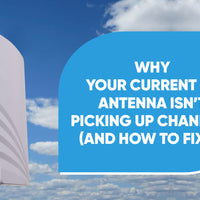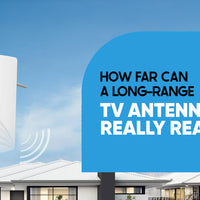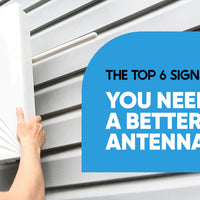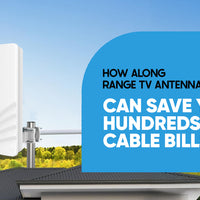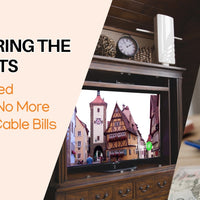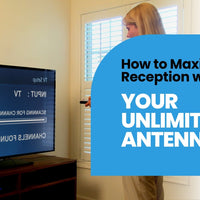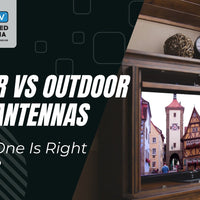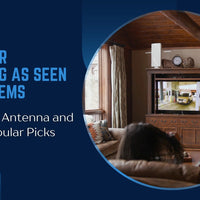Summary
- Weather and terrain have a major impact on OTA TV reception, causing pixilation, dropouts, or lost channels.
-
Rain, snow, humidity, wind, mountains, valleys, and buildings can scatter, block, or weaken signals.
Unlimited Antenna’s weather-resistant indoor and outdoor models help overcome these obstacles with up to a 100-mile range. - Proven solutions include optimal placement, elevation, using directional or amplified antennas, and weatherproofing your setup.
- With smart positioning and maintenance, you can enjoy clear, reliable OTA TV rain or shine, hill or valley.
Cutting the cord and switching to over-the-air (OTA) TV is a game-changer free access to local channels, stunning HD quality, and no monthly bills. But if you’ve ever watched your Unlimited Antenna struggle during a thunderstorm or drop channels in a hilly neighborhood, you know that weather and terrain can wreak havoc on signal reception.
Rain, snow, humidity, wind, mountains, valleys, and urban buildings can scatter, block, or weaken the radio waves your antenna relies on, turning your favorite show into a pixelated mess or a blank screen.
The good news? You can outsmart these challenges with strategic antenna placement, the right antenna type, and weatherproofing solutions. Unlimited Antenna’s weather-resistant indoor and outdoor models, boasting up to a 100-mile range, are built to tackle tough conditions.
This guide dives deep into how weather and terrain affect your TV antenna’s performance and offers detailed, actionable steps to ensure crystal-clear reception, no matter what Mother Nature or your landscape throws at you.
How Weather Impacts TV Antenna Reception
Weather is a major player in OTA TV reception, as it directly affects the radio waves your Unlimited Antenna captures. Digital signals, unlike old analog TVs’ snowy static, are unforgiving when disrupted; you get pixilation, stuttering audio, or a complete signal dropout.
Understanding how specific weather conditions impact your antenna helps you anticipate issues and take preventive measures. Here’s a detailed breakdown of each factor and how it challenges your Unlimited Antenna’s performance.
Precipitation
Rain, snow, and ice are notorious for interfering with OTA signals by scattering or absorbing radio waves.
Rain Mechanics: Dense raindrops act like tiny prisms, scattering electromagnetic waves in the VHF (30–300 MHz) and UHF (300–3000 MHz) bands used by TV stations. Heavy storms can reduce signal strength by 5–15 dB, enough to cause pixelation or loss of weaker channels. The effect is worse for distant towers (40+ miles), even with Unlimited Antenna’s 100-mile range.
Snow and Ice: Light snow scatters signals less severely, but heavy snowfall or ice buildup on your antenna can be problematic. Ice adds weight, potentially misaligning your antenna, and forms a physical barrier that blocks signal capture. For example, a 1-inch ice layer can cut signal strength by 10–20%, especially on smaller indoor antennas.
Real-World Impact: During a Midwest blizzard, a user with an Unlimited Antenna outdoor model noticed their NBC channel dropping. After clearing ice from the antenna and checking alignment, reception returned to normal, highlighting the need for post-storm maintenance.
Mitigation Tips:
- Use Unlimited Antenna’s weather-resistant outdoor model, designed to withstand rain and snow.
- After heavy precipitation, inspect for ice or water pooling on antenna elements and clear it with a soft brush.
-
Elevate your antenna (e.g., rooftop) to minimize ground-level snow accumulation.
Humidity
High moisture in the air, even without rain, can degrade signal quality by scattering radio waves.
- How It Works: Fog, mist, or high humidity introduces water droplets that absorb and scatter signals, particularly in the UHF band. In humid climates (e.g., coastal areas), signal strength can drop by 3–10 dB, causing intermittent pixelation on distant or weaker stations.
- Impact on Unlimited Antenna: Indoor antennas, like Unlimited Antenna’s compact models, may struggle in humid indoor environments (e.g., near unventilated bathrooms). Outdoor models are less affected but still face signal dampening in extreme humidity.
- Real Scenario: A user in Louisiana reported their Unlimited Antenna indoor model losing a 45-mile-away FOX channel during a humid summer. Moving it to a drier, south-facing window and adding a small fan to reduce indoor moisture restored the signal.
Mitigation Tips:
- Place indoor antennas in well-ventilated areas away from humid sources (e.g., kitchens).
- Use Unlimited Antenna’s outdoor model in humid regions, as its weather-resistant coating minimizes moisture interference.
- Check signal strength with a meter during humid days to adjust placement for optimal reception.
Wind
Strong winds can physically disrupt your antenna’s alignment or cause structural damage, directly impacting signal quality.
- Misalignment Risks: Gusts above 30 mph can shift even sturdy antennas like Unlimited Antenna’s outdoor models, throwing off their line-of-sight to broadcast towers. A 10-degree misalignment can reduce signal strength by 10–20 dB, enough to lose multiple channels.
- Debris Damage: Windblown branches, leaves, or debris can lodge in antenna elements or block signal paths, especially in wooded areas.
- Long-Term Effects: Repeated wind exposure can loosen mounting hardware or stress coaxial cables, leading to signal degradation over time.
- Real-World Fix: After a stormy night with 40 mph gusts, a rural user found their Unlimited Antenna outdoor model had tilted westward. Re-securing the mast and realigning it toward a 60-mile-away tower using a compass restored 28 channels.
Mitigation Tips:
- Use Unlimited Antenna’s included mounting kit, rated for winds up to 60 mph, and reinforced with heavy-duty brackets in windy regions.
- Inspect your antenna after storms for debris or misalignment, using a signal meter to verify performance.
- Trim nearby branches to reduce windblown obstructions.
Temperature Swings
Rapid temperature changes can affect your antenna’s physical components, leading to subtle but cumulative issues.
-
Expansion/Contraction: Metal elements in Unlimited Antenna (e.g., mast, dipole arms) expand in heat (e.g., 90°F summers) and contract in cold (e.g., 10°F winters), potentially loosening bolts or coaxial connectors. Over the years, this can cause signal loss by 2–5 dB due to poor connections.
-
Cable Degradation: Extreme heat can dry out coaxial cable insulation, while freezing temperatures can make it brittle, increasing signal leakage.
-
Impact: While not immediate, unchecked temperature effects can degrade reception, especially in regions with four-season climates.
-
Real Scenario: A user in Minnesota noticed signal dropouts after a winter freeze-thaw cycle. Tightening loose coaxial connectors on their Unlimited Antenna outdoor model and applying weatherproof tape fixed the issue.
Mitigation Tips:
- Check connections annually, especially before winter, to ensure they’re tight and free of corrosion.
- Use Unlimited Antenna’s weather-resistant coaxial cables, designed for temperature extremes.
- Store indoor antennas away from heat sources (e.g., radiators) to prevent material stress.
How Terrain Impacts TV Antenna Reception
Terrain is a silent but powerful factor in OTA reception. Your Unlimited Antenna needs a clear line-of-sight to broadcast towers to capture strong signals, but natural and man-made obstacles can block, reflect, or weaken those signals.
Understanding your local terrain helps you position your antenna for success. Here’s a deep dive into how specific terrain features affect reception and how to adapt.
Mountains/Hills
Elevated terrain can act as an impenetrable barrier for radio waves.
- Mountains or hills between your antenna and towers absorb or deflect signals, reducing strength by 10–30 dB or blocking them entirely. The higher and closer the obstruction, the worse the impact, especially for towers 50+ miles away.
- Even with a 100-mile range, Unlimited Antenna’s outdoor models may struggle in mountainous areas if towers are behind peaks. Indoor antennas are particularly vulnerable due to lower elevation.
- Radio waves in the UHF band (470–698 MHz) are more susceptible to terrain blockage than VHF (174–216 MHz), so channels on UHF may drop first.
- A user in Montana’s Bitterroot Mountains received only 3 channels with an Unlimited Antenna indoor model due to a 2000-foot ridge. Switching to an outdoor model on a 20-foot mast cleared the ridge, boosting channel count to 18.
Mitigation Tips:
Use AntennaWeb.org to confirm tower locations and identify obstructing hills.
- Mount Unlimited Antenna’s outdoor model on a tall mast or rooftop to gain elevation above terrain.
- Consider a directional antenna to focus signal capture on specific towers.
Valleys
Low-lying areas can trap signals, creating reception dead zones.
- Valleys surrounded by hills or mountains act like bowls, preventing radio waves from reaching your antenna. Signals may diffract over ridges but lose significant strength (10–20 dB), especially for distant towers.
- Indoor antennas in valleys often receive weak or no signals, while outdoor models need significant elevation to escape the terrain trap.
- Valleys exacerbate multipath interference, where signals bounce off surrounding terrain, arriving out of phase and causing pixilation.
- A user in a Pennsylvania valley got only 4 channels with an Unlimited Antenna indoor model. Installing an outdoor model on a 30-foot pole above the valley floor increased channels to 25, capturing signals from 70 miles away.
Mitigation Tips:
- Use FCC DTV Maps to check if your valley is in a signal shadow.
- Elevate Unlimited Antenna’s outdoor model as high as possible (e.g., rooftop or tower).
- Test with a signal meter to find the optimal height and direction for signal capture.
Buildings/Trees
Urban and suburban environments introduce man-made and natural obstructions.
- Tall buildings, skyscrapers, or dense tree canopies reflect or absorb signals, causing multipath interference or signal loss. A single high-rise can reduce signal strength by 5–15 dB, while thick foliage can attenuate signals by 3–10 dB.
- Indoor antennas, like Unlimited Antenna’s compact models, struggle in cities with high-rises or heavily wooded suburbs. Outdoor models perform better but still need clear sightlines.
- Multipath interference creates “ghosting” in digital signals, where multiple signal paths confuse your TV’s tuner, leading to dropouts.
- A Chicago user moved their Unlimited Antenna indoor model from a tree-shaded window to a high, unobstructed balcony, jumping from 8 to 30 channels by avoiding nearby oaks and a 10-story building.
Mitigation Tips:
- Place indoor antennas near windows facing towers, away from trees or buildings.
- Use Unlimited Antenna’s outdoor model on a rooftop or mast to clear urban obstructions.
- Trim overhanging branches to reduce foliage interference, if feasible.
Solutions to Boost Antenna Performance
Weather and terrain challenges are tough, but not insurmountable. With Unlimited Antenna’s weather-resistant, multi-directional designs and a few strategic tweaks, you can maximize signal strength and enjoy uninterrupted OTA TV.
Here’s a detailed guide to optimizing your setup for any environment.
Optimize Line-of-Sight
A clear line of sight to broadcast towers is essential for strong and consistent signal reception. To begin, use resources like AntennaWeb.org or the FCC DTV Maps to locate nearby broadcast towers. These tools show tower locations, distances, and compass bearings based on your ZIP code. For example, entering a ZIP code might reveal 20 stations within a 60-mile range, many of which could be clustered in a specific direction such as northeast.
AntennaWeb.org provides color-coded maps that indicate signal strength. Green represents strong signals while red shows weaker ones, helping you assess whether Unlimited Antenna’s 100-mile range is sufficient or if additional elevation might be needed. FCC maps offer detailed signal contours that help with precise antenna placement.
To get the best results, align Unlimited Antenna’s outdoor model toward the strongest cluster of towers. You can use a traditional compass or a smartphone app for accurate positioning. If towers are spread across different directions, the antenna’s multi-directional design helps capture signals from multiple angles without manual adjustments.
In one real-world example, a suburban user located towers 45 miles north using Antennaweb.org After carefully aligning their Unlimited Antenna outdoor model, they saw a signal strength improvement from 50 dB to 75 dB and gained access to 10 new channels.
If towers are located in multiple directions, activate the antenna’s multi-directional mode or use a rotator with directional models to switch focus between tower clusters efficiently.
Choose the Right Antenna
Choosing the right antenna is key to overcoming weather conditions and terrain challenges. Your location and signal environment will determine whether a directional, amplified, indoor, or outdoor antenna is the best fit.
Directional antennas are ideal for rural or mountainous areas where towers are concentrated in one direction. These antennas offer higher gain, typically between 10 and 15 dB, which enhances signal capture over long distances. This setup works well with Unlimited Antenna’s outdoor models, which are designed to reach up to 100 miles. Directional antennas require precise aiming, which can be guided by FCC maps or a handheld signal meter.
Amplified antennas are designed to boost weak signals, especially in areas affected by humidity, rain, or physical obstructions like valleys. Many of Unlimited Antenna’s outdoor models support low-noise amplifiers, although it’s important to confirm compatibility. In areas with already strong signals, avoid over-amplification, as it can lead to signal distortion.
Indoor models are best suited for urban settings within 30 to 45 miles of broadcast towers. While compact and easy to install, they may struggle with reception in areas with hills, trees, or high humidity. Outdoor models, on the other hand, are built to withstand harsh conditions and offer higher gain, making them more suitable for rural or obstructed environments.
In one case, a user living in a hilly region upgraded from an indoor unit to an Unlimited Antenna outdoor directional model. By focusing the antenna on a tower cluster located 75 miles away, they were able to access 18 additional channels.
Strategic Placement
Proper height and positioning play a major role in overcoming environmental interference. Elevation helps clear obstructions and improves overall signal strength.
Mount the Unlimited Antenna outdoor model on a rooftop, in an attic, or on a 20 to 30-foot mast. Gaining height can help clear nearby trees, buildings, or hills, with each foot of elevation potentially improving signal strength by 1 to 3 dB. For indoor antennas, placing the unit near a high window or wall that faces the towers can also improve performance.
Keep antennas away from potential signal disruptors such as metal objects, HVAC systems, Wi-Fi routers, and power lines. In densely built urban areas, try multiple window positions to determine which provides the clearest line of sight to the towers.
After storms or high winds, check antenna alignment using a signal meter or your TV’s built-in diagnostics (usually found under Settings > Channel Setup). Reposition the antenna if necessary and rescan for channels to capture any new or improved signals.
In one real-world scenario, a user living in a wooded suburb moved their Unlimited Antenna outdoor model from an attic, where it was obstructed by a metal roof, to a rooftop mast. This simple change cleared tree cover and storm debris, resulting in 15 additional channels.
Use a bubble level to ensure your mast is installed vertically. A properly aligned mount maximizes signal capture and long-term performance.
Weatherproofing
Weatherproofing your antenna system helps maintain strong reception and extends the life of your equipment, especially in areas with extreme weather.
Use high-quality, weatherproof coaxial cables with sealed RG6 connectors to prevent moisture intrusion. This is especially important in rainy or humid environments. Make sure cables are UV-resistant to withstand prolonged exposure to sunlight.
Install your Unlimited Antenna using a wind-resistant mounting kit rated for gusts up to 60 mph. In hurricane-prone areas, consider reinforcing the setup with guy wires or heavy-duty brackets. Choose rust-proof mounting materials to prevent corrosion, particularly in coastal regions.
Before winter or rainy seasons, inspect the antenna and cables for signs of wear. Look for ice buildup, rust, or loose bolts. Gently clear any debris using a soft brush and tighten all connections. Applying weatherproofing tape or silicone sealant to coaxial connectors adds an extra layer of protection against rain and temperature fluctuations.
In one coastal example, a user weatherproofed their Unlimited Antenna outdoor model using sealed cables and protective tape. Despite a long rainy season, they maintained access to more than 30 channels without any signal loss.
Store extra coaxial cables indoors to protect them from deterioration. Swap them out every two to three years to ensure continued performance.
FAQs
Got questions about weather, terrain, and your Unlimited Antenna? Here are detailed answers to common concerns.
Can the weather permanently damage my antenna?
Answer: Permanent damage is rare, but prolonged exposure to moisture, wind, or ice can cause wear. For example, rust on connectors or cracked cable insulation can reduce signal strength by 5–10 dB over time.
Unlimited Antenna’s weather-resistant design minimizes these risks, but regular maintenance is key:
- Check for corrosion or water damage after heavy storms.
- Clear ice buildup gently to avoid bending antenna elements.
- Replace damaged cables promptly to restore performance.
Do metal roofs interfere with signals?
Answer: Yes, metal roofs reflect or block radio waves, reducing signal strength by 10–20 dB for indoor or attic antennas.
For example, a user with an Unlimited Antenna indoor model under a metal roof received only 3 channels. Solutions include:
- Mount the Unlimited Antenna’s outdoor model above the roofline on a mast.
- Use an outdoor antenna with higher gain to overcome roof interference.
- Test signal strength with a meter to confirm roof impact.
How do I know if terrain is the issue?
Answer: Terrain is likely the culprit if you receive fewer channels than expected or experience inconsistent signals. To confirm:
- Use AntennaWeb.org or FCC DTV Maps to check for hills, valleys, or buildings between you and the towers.
- Test with a signal meter to measure strength and quality, noting drops in specific directions.
- Consult a professional for a site survey if signals remain weak despite high placement.
- Example: A user in a valley used FCC maps to identify a blocking ridge, then installed an Unlimited Antenna outdoor model on a 25-foot mast to clear it, gaining 20 channels.
Final Tip
Weather and terrain can test even the best TV antennas, but with Unlimited Antenna, you’re ready to conquer both. Regularly inspect your setup before peak weather seasons, spring storms, winter blizzards, or fall winds, and make small adjustments to keep signals strong.
Check alignment, clear debris, and tighten connections after extreme conditions. A quick tweak, like elevating your antenna or adding weatherproofing tape, can mean the difference between missing your favorite game and enjoying it in HD.
Ready to experience reliable OTA TV? Try Unlimited Antenna’s weather-resistant indoor and outdoor models for unbeatable performance in any environment.


